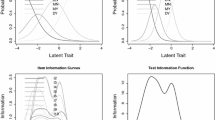Abstract
Taking into account the students’ evaluation of the quality of degree programs this paper presents a proposal for building up an adjusted performance indicator based on Latent Class Regression Analysis. The method enables us (i) to summarize in a single indicator statement multiple facets evaluated by students through a survey questionnaire and (ii) to control the variability in the evaluations that is mainly attributable to the characteristics (often referred as the Potential Confounding Factors) of the evaluators (students) rather than to real differences in the performances of the degree programs under evaluation. A simulation study is implemented in order to test the method and assess its potential when the composition of the degree programs as regards to students’ characteristics is sensibly different between one another. Results suggest that when the evaluations are strongly affected by the students’ covariates, the assessment based on the value of an unadjusted indicator can lead to bias and unreliable conclusions about the differences in performance. An application to real data is also provided.
Similar content being viewed by others
References
Agresti A (2002) Categorical data analysis. Wiley-Interscience, Hoboken
Bartholomew DJ (1998) Scaling unobservable constructs in social science. Appl Stat 47: 1–13
Bartholomew DJ, Steele F, Moustaki I, Galbraith JI (2002) The analysis and interpretation of multivariate analysis for social scientists. Chapman & Hall, Boca Raton
Bayol MP, de la Foye A, Tellier C, Tenenhaus M (2000) Use of PLS path modelling to estimate the European consumer satisfaction index (ECSI) model. Stat Appl 12(3): 361–375
Bird SM, Cox D, Goldstein H, Holt T, Smith PC (2005) Performance indicators: good, bad and ugly. J R Stat Soc A 168(1): 1–27
Capursi V, Porcu M (2001) La didattica universitaria valutata dagli studenti: un indicatore basato su misure di distanza fra distribuzioni di giudizi. In: Atti Convegno Intermedio della Società Italiana di Statistica ‘Processi e Metodi Statistici di Valutazione’, Roma 4–6 giugno 2001. Società Italiana di Statistica
Cox DR, Fitzpatrick R, Fletcher AE, Gore SM, Spiegelhalter DJ, Jones DR (1992) Quality of life assessment: can we keep it simple?. J R Stat Soc A 155: 353–393
Draper D, Gittoes M (2004) Statistical analysis of performance indicators in UK higher education. J R Stat Soc A 167(3): 449–474
Goldstein H, Spiegelhalter DJ (1996) League tables and their limitations: statistical issues in comparisons of istitutional performance. J R Stat Soc A 159: 385–443
Grilli L, Rampichini C (2007) Multilevel factor models for ordinal variables. Struct Equ Model A Multidiscip J 14(1): 1–25
Hagenaars JA, McCutcheon AL (2002) Applied latent class analysis. Cambridge University Press, Cambridge
Lanza ST, Collins LM, Lemmon DR, Schafer JL (2007) PROC LCA: a SAS procedure for latent class analysis. Struct Equ Model A Multidiscip J 14(4): 671–694
Leckie G, Goldstein H (2009) The limitation of using school league tables to inform school choice. J R Stat Soc A 172(4): 835–851
Leti G (1983) Statistica Descrittiva. Il Mulino, Bologna
Linzer DA, Lewis J (2010) poLCA: polytomous variable latent class analysis. R package version 1.2. http://userwww.service.emory.edu/~dlinzer/poLCA/
Moustaki I, Knott D (2000) Generalized latent trait models. Psychometrika 65: 391–411
Quatto P (2011) Descriptive analysis of student ratings. Book of short abstracts IES 2011. (http://ies2011.ds.unifi.it/BookOfAbstractsIES2011.pdf)
Rampichini C, Grilli L, Petrucci A (2004) Analysis of university course evaluations: from descriptive measures to multilevel models. Stat Methods Appl 13(3): 357–371
Skrondal A, Rabe-Hesketh S (2004) Generalized latent variables modeling. Chapman & Hall, Boca Raton
Sulis I, Porcu M (2011) Assessing the quality of the management of degree programs by latent class analysis. In: Attanasio M, Capursi V (eds) Statistical methods for the evaluation of university systems, series contributions to statistics. Springer, Berlin, pp 161–172
Vermunt JK (2003) Multilevel latent class models. Sociol Methodol 33: 213–234
Vermunt JK (2008) Latent class and finite mixture models for multilevel data sets. Stat Methods Med Res 17: 33–51
Author information
Authors and Affiliations
Corresponding author
Rights and permissions
About this article
Cite this article
Sulis, I., Porcu, M. Comparing degree programs from students’ assessments: A LCRA-based adjusted composite indicator. Stat Methods Appl 21, 193–209 (2012). https://doi.org/10.1007/s10260-011-0185-9
Accepted:
Published:
Issue Date:
DOI: https://doi.org/10.1007/s10260-011-0185-9




